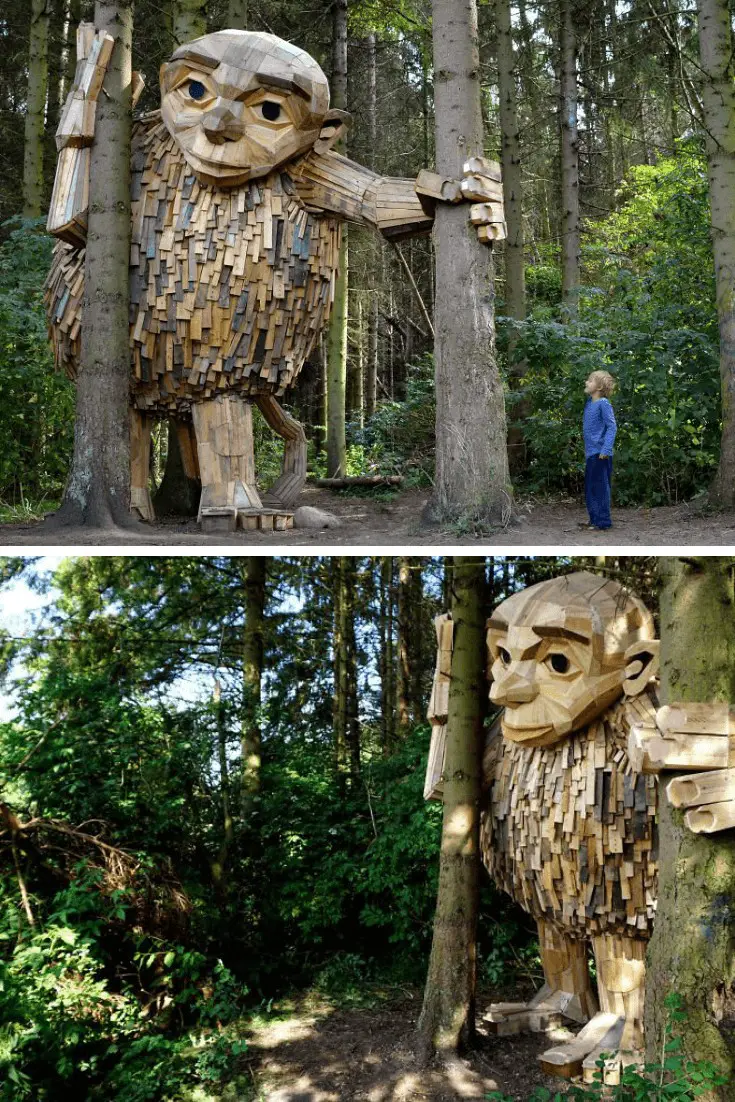38+ Trees With White Flowers (With Pictures)
When it comes to finding a touch of elegance and sophistication in your outdoor space, few things can match the beauty of white flowering trees. Whether you’re looking for a burst of color in the spring or a delicate display throughout the year, there are many types of trees that sport stunning white blooms. From small shrubs to towering canopies, these trees offer a range of options for any landscape.
Some of the most striking examples include the American elderberry, with its clusters of tiny white flowers, and the Bridal Wreath Spirea, which produces delicate, lacy white blooms. For those looking for something more dramatic, the Giant Dogwood’s large, showy white flowers are a standout. Of course, not all white flowering trees are created equal. Some, like the Angel’s Trumpet and Buttonbush, produce massive, trumpet-shaped blooms that are sure to turn heads.
Others, like the Carolina Silverbell and Natal Plum, offer more subtle, yet still beautiful, displays of white flowers. Beyond just their looks, many of these trees also provide additional benefits, such as fragrant leaves or berries that attract wildlife. And with so many options to choose from, you’re sure to find the perfect tree for your outdoor space, whether you’re looking for something to bloom in the spring, summer, fall, or winter.
If you’re looking for more information on these beautiful trees, be sure to check out our related posts on types of oak, hickory, pine, elm, birch, willow, and walnut trees.
How do you identify a white flowering tree?
While there is no straightforward method to predict whether a tree will produce white flowers, having prior knowledge of different variants and cultivars that bloom with white flowers can be incredibly useful. By understanding the characteristics of these trees, including their size, natural habitat, form, leaves, bark, and fruits, you can make informed comparisons and identify potential matches.
Types Of Trees With White Flowers
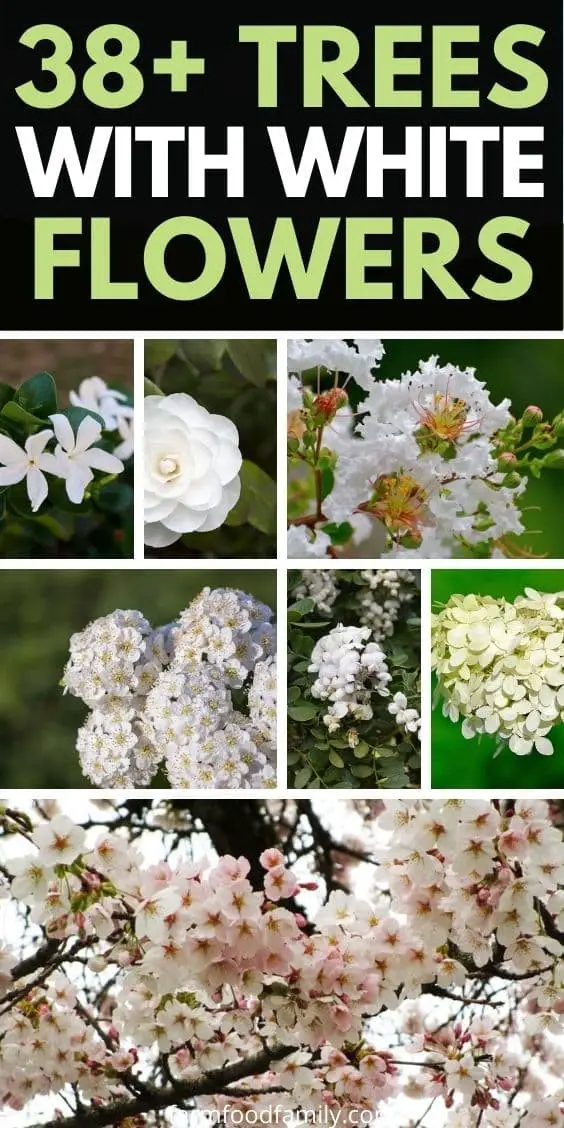
Trees with small white flowers
American elderberry (Sambucus canadensis)
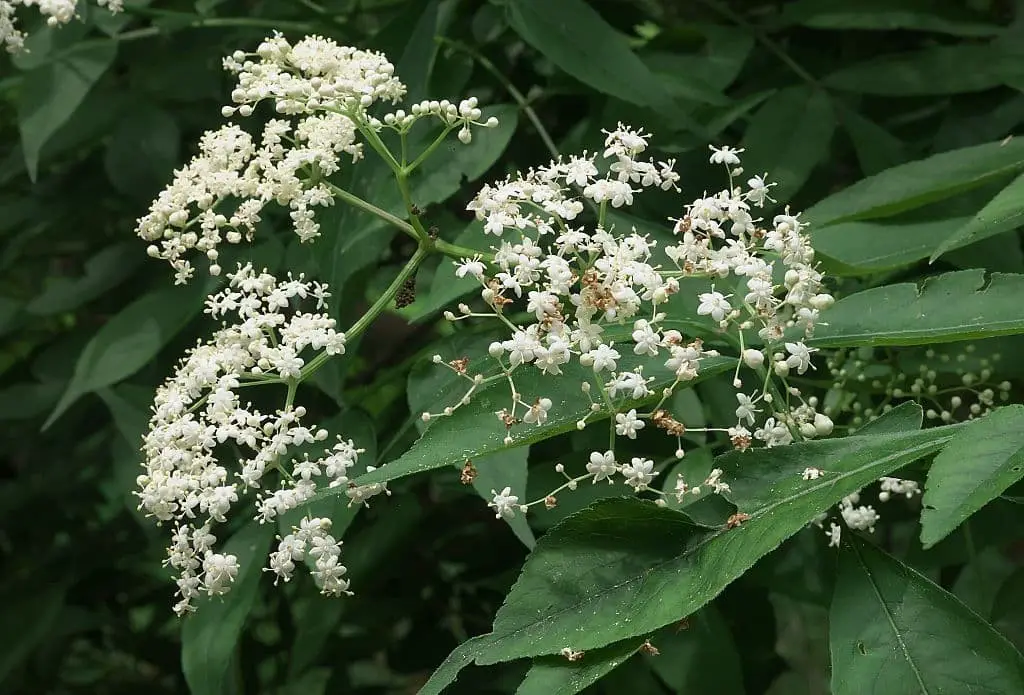
This landscape tree boasts a unique feature – clusters of tiny, white blooms that emerge during the spring season. Its natural habitat is characterized by wet soils, making it an ideal choice for rain gardens. One important consideration when planting this species is regular pruning to manage its growth habit, which involves producing suckers. When in bloom, the tree produces lemon-scented flowers, adding a delightful fragrance to the surrounding environment.
Bridal wreath spirea (Spirae aprunifolia)

One of the most eye-catching trees is the tree that produces an abundance of small, radiant white flowers during the summer season. Its slender growth habit gives it a wispy appearance. What sets this tree apart is its unique characteristic: the blooms appear before its foliage. Due to its modest height, it’s often used as a hedge plant or accent tree in summer gardens, providing a beautiful pop of color and texture.
Carolina silverbell

The Southern magnolia, a flowering tree endemic to the US’s southern regions, begins blooming small white flowers in early summer. A notable characteristic is the simultaneous sprouting of these blooms along its leafy foliage. In its native habitat of Appalachian woods, this tree can reach a maximum height of 60 feet, often found alongside thriving rhododendrons and azaleas.
Giant dogwood (Cornus controversa)

The Cornus species boasts one of its largest trees, which can reach an impressive maximum height of 80ft. Originating from Asian countries such as China and Japan, this majestic tree is characterized by its flat, creamy white clusters of small flowers that bloom throughout the summer months.
While it’s often utilized as a lawn tree, its profuse blue-black berries sprouting in late summer can lead to a bit of messiness, making it crucial to consider when deciding to incorporate this species into your outdoor space.
Natal plum (Carissa macrocarpa)

This tropical tree, though rare to bloom during the summer season, is a remarkable sight to behold. Standing at just 20ft tall, it produces stunning flowers measuring around 2 inches in diameter, with each bloom featuring a star-shaped design. As these showstopping flowers fade away, a new treat emerges in the form of plum- or cranberry-like fruits that are edible and can be used to create jams, jellies, and other sweet treats.
Not only do they add a pop of color as accent plants in containers for patios and decks, but they’re also incredibly resilient, capable of thriving in a wide range of soil conditions.
Trees with big white flowers
Angel’s trumpet

This versatile plant can be pruned to thrive as either a compact shrub or a majestic tree, stretching up to 20 feet in height. Its robust stems support striking trumpet-shaped flowers that can reach an impressive 12 inches in diameter. These blooms burst forth from summer to fall, painting the landscape with vibrant colors. As a landscape plant, it’s particularly well-suited for warmer climates.
When grown as shrubs, they’re often used as container plants on patios and decks, adding a touch of elegance to outdoor spaces.
Buttonbush

Reaching heights of up to 20 feet, this North American native boasts stunning, cushion-pine-like blooms in a pure white hue. These showy flowers emerge during mid-to-late summer, drawing in butterflies and other pollinators with their rounded, open petals. As an added bonus, this tree thrives in the unique conditions surrounding water features and wet soils, making it an excellent choice for rain gardens.
Kobus magnolia (Magnolia kobus)

The Magnolia tree produces striking white flowers with a sweet fragrance from March onwards. Following the blooming season, its glossy foliage emerges, showcasing a rounded and spreading shape that can reach up to 40ft in height. As fall arrives, the tree develops seed pods, making it a popular haven for birds and other wildlife. Notably, despite its tall stature, this species is relatively low-maintenance and commonly used as a lawn tree or hedge plant due to its small growth requirements.
Trees with white flowers in spring
Chinese fringe trees (Chionanthus retusus)

This tree, known for its robust growth pattern, consists of multiple stems that give rise to a dense, rounded canopy. Its leaves are characterized by their unique elliptical shape and dark green color, which is often described as leathery. As the name suggests, this species is native to East Asia, specifically China, Korea, and Japan. One of its most striking features is the profusion of small, scented flowers that bloom in a fringe-like pattern.
These blooms are a pure white hue, adding to their charm. The tree thrives in conditions ranging from full sun to dappled light.
Yoshino cherry (Prunus × yedoensis)

For a stunning visual display, consider the Yoshino cherry, native to China, Korea, Japan, and Taiwan. This medium-sized tree boasts elliptical, serrated foliage that transforms into a warm bronze hue during autumn. In the spring, it bursts forth with clusters of creamy white flowers, followed by the appearance of black berries. The Yoshino cherry thrives in full sun or dappled light, making it an ideal choice for those seeking a tree that’s both beautiful and low-maintenance.
Its striking visual appeal makes it a popular option among gardeners and nature enthusiasts alike.
Crabapple
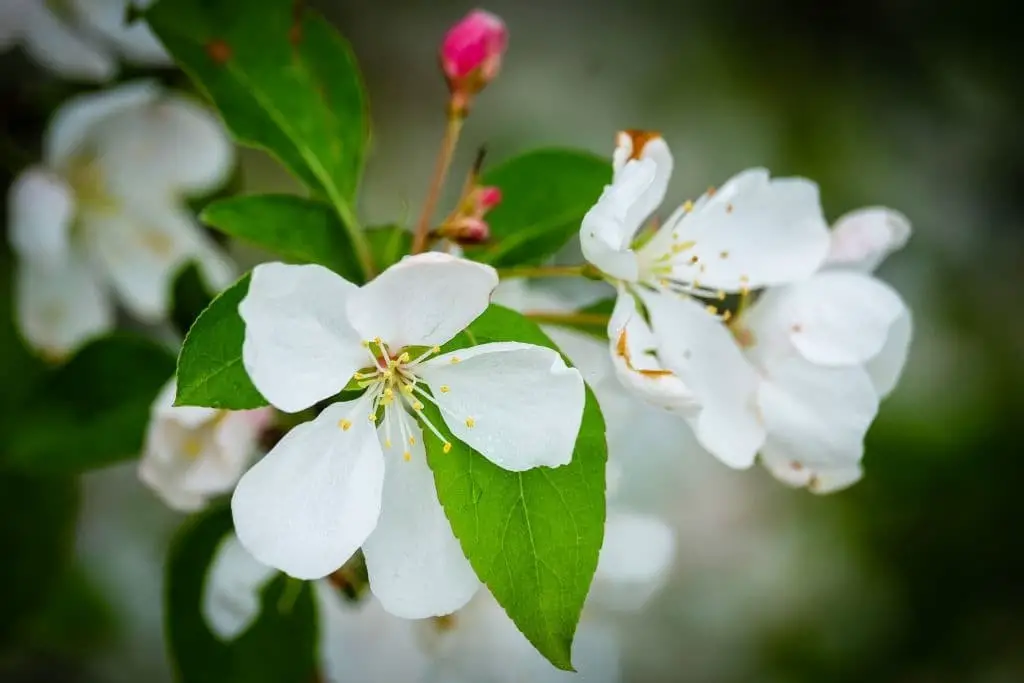
In the tropical and temperate climates of North America, Europe, and Asia, a medium-sized tree thrives, boasting a unique characteristic: its seasons are marked by distinct changes. Spring brings forth clusters of white flowers, followed by the emergence of yellow, green, and red apple fruits. The leaves, too, undergo a transformation during autumn, transforming from green to vibrant hues of reddish-purple or yellow-orange.
While the crabapple’s fruits cannot be consumed raw, they do find practical applications in the creation of sweet treats like tarts, jellies, jams, and other preserves.
Japanese crepe myrtle

The medium-sized tree is a showstopper in spring gardens, thanks to its clusters of vibrant white flowers that are perfectly complemented by its distinctive cinnamon-colored bark. The tree’s deep green, glossy foliage and rounded, dense crown only add to its visual appeal. As a bonus, this tree is also gaining popularity as a specimen tree due to its adaptability.
While it thrives in tropical and temperate climates, it can surprisingly adjust to colder locations, making it a great option for gardeners looking to add some extra drama to their outdoor spaces.
Callery pear (Pyrus calleryana)

The Cleveland pear tree, also known by its moniker, is renowned for its rapid growth rate and ornamental value. Its upright branches are adorned with clusters of small, radiant white flowers, making it a stunning visual display. The tree’s leaves are equally impressive, showcasing a vibrant color palette that transitions from bright red to orange, punctuated by golden yellow hues as autumn sets in.
A low-maintenance option for any landscape, the Cleveland pear tree excels in full sun and well-draining soils.
Fragrant trees with white flowers
Southern magnolia (Magnolia grandiflora)

The majestic A-lister tree is renowned for its breathtakingly beautiful white blooms, emitting a captivating aroma reminiscent of sweet vanilla. Its robust yet compact physique, adorned with dark brown bark and lustrous, deep green leaves with a leathery texture, allows it to thrive as a medium-sized tree.
As the seasons transition from spring to mid-summer, this stunning specimen bursts forth with large, cup-shaped flowers that fill the air with their heady scent, wafting gently across the surrounding landscape. Moreover, its fragrant blooms have been employed in the creation of leis in tropical US states like Hawaii, where they are cherished for their allure and versatility.
Purple leaf sandcherry (Prunus × cistena)

This small yet remarkable tree is distinguished by its vibrant purple foliage, which steals the show long before its flowers bloom. The flowers themselves are a sight to behold, transitioning from a soft pink hue to a brilliant white as they mature. Standing at an impressive 20ft in height and spreading outwards by 10ft, this tree is an ideal choice for ornamental or specimen gardens.
Its unique charm extends beyond its foliage, as it produces fruits that provide sustenance for birds, adding yet another layer of beauty and functionality to its already impressive profile.
Tea olive (Osmanthus fragrans)

This unique tree’s blooming season is characterized by its ability to thrive in temperate climates, free from extreme heat or cold. During this timeframe, typically between spring and fall, it produces clusters of small, white, and fragrantly scented flowers. The consensus among experts is that the fragrance emitted by these blooms combines notes of rose, jasmine, and gardenia, with a signature sweet and lemony aroma during spring.
Reaching up to 12 feet in height, this tree makes for an excellent accent plant in areas like pool sides or around fences, adding visual interest to its surroundings.
Night blooming jasmine (Cestrum nocturnum)

The Gardenia jasminoides is a woody shrub that can be pruned to form a compact tree, boasting small, star-shaped flowers with an intensely fragrant aroma. The plant’s unique scent is characterized by notes of vanilla, lemon, and white florals, which only bloom at night under the veil of darkness.
Its foliage is equally striking, featuring leathery leaves with a deep green hue that adds to its aesthetic appeal.
Reaching heights of up to 13 feet, this versatile plant thrives in tropical climates, but it also requires periodic exposure to cold and damp air to flourish.
Japanese flowering apricot (Prunus mume)

In spring, this unique shrub produces an enchanting display of white-to-pink flowers, casting a spell of charm over winter gardens. Reaching the same height as dogwoods or redbuds, it stands tall with a classic sweetness that evokes memories of childhood whimsy. Despite its beauty, however, it can be quite elusive to find and acquire, making it all the more special for those who do stumble upon it.
Camellia

While often overlooked, camellias can be coaxed into growing as small to medium-sized trees, reaching heights of up to 15 feet. Their floral displays are particularly striking, with delicate white and pink blooms being the most visually appealing. Furthermore, these trees emit a distinct scent reminiscent of spring – a harmonious blend of sweetness, lemony freshness, and subtle muskiness.
What’s more, camellias have the unique ability to produce flowers almost year-round, ensuring that the sweet aroma they release can be enjoyed throughout all four seasons when planted in your landscape.
Trees with purple and white flowers
Jacaranda tree (Jacaranda mimosifolia)

This majestic tree boasts an array of striking features, including fern-like foliage, delicate purple blooms with vibrant yellow centers, and elegant white streaks. Its rapid growth rate allows it to reach heights of up to 30 feet, providing ample shade for outdoor spaces like patios, courtyards, and decks. Moreover, its stature makes it a standout front yard specimen tree, instantly elevating the curb appeal of any home.
Chaste tree (Vitex agnus-castus)

Vitex, also known as Chastetree, is a breathtakingly beautiful plant that can grow up to 20 feet tall. Its delicate clusters of lilac-colored flowers with white streaks at the top are truly captivating. As the seasons change, the gray-green leaves that emerge in spring create a visually stunning display in courtyards and gardens. This lovely plant is a magnet for pollinators such as hummingbirds, butterflies, and bees, which flock to it to feast on its abundant blooms.
The unique multi-twist stems add an extra layer of visual interest, making Vitex a standout addition to any outdoor space.
Texas mountain laurel (Sophora secundiflora)

The beauty of the spring tree lies not only in its profusion of purple and white hues, but also in the tender blue undertones that add depth to its charm. Considered one of the most stunning spring trees, it’s an ideal addition to any yard. Its small stature belies a surprising secret: during the spring season, this compact beauty fills the air with the sweet scent of grape juice. But what truly sets it apart is its remarkable tolerance for arid environments and even frosty conditions.
Additionally, its compact size makes it an excellent choice for any space in your yard, fitting seamlessly into tight corners or sprawling lawns alike.
Royal Empress tree (Paulownia tomentosa)

Native to Eastern Asia, the tree is renowned for its rapid growth rate, although its wood can be prone to brittleness. In some US states, such as Pennsylvania, it’s considered an invasive species due to its ability to spread quickly. However, its showy clusters of trumpet-shaped, pale purple flowers – which can appear creamy white in tone – are a significant draw.
The blooms themselves are also highly fragrant, while the tree’s heart-shaped leaves are notable for their large size and deep green coloration.
Burgundy desert willow (Chilopsis linearis, ‘Burgundy’)
The Texas Sagebrush (Leucophyllum frutescens) is a striking plant that can grow up to 30ft tall, showcasing vibrant purple, burgundy, and white flowers. As the seasons change, its bell-shaped blooms transform into brown capsules, which are a delight for birds and other wildlife. Notably, this drought-tolerant species thrives in full sun and has adapted well to arid conditions.
Its natural habitat is found primarily in the US, with Texas, New Mexico, and California being specific areas where it can be commonly spotted.
Fruit tree with white flowers
Fuji apple tree (Malus domestica ‘Fuji’)

The Fuji apple tree is renowned for its vibrant springtime displays, but what’s less well-known is that it begins by producing clusters of sweet-scented white blooms. This deciduous tree thrives in cooler temperatures and, while it adores basking in the sun, it’s not particularly fond of dry conditions. Just imagine a lush orchard teeming with these trees, where the fleeting beauty of blooming season is simply a precursor to an abundance of crisp, juicy Fuji apples.
Hosui Asian pear tree

This diminutive tree stands at a modest 12 feet tall, boasting rapid growth and charming white blooms reminiscent of daisies. These flowers emerge before the fruit appears in summer, marking the beginning of an exciting growing season.
As the fruits mature, they reveal a unique flavor profile that seamlessly blends the sweetness of apples with the buttery notes of pears.
One of this tree’s most impressive attributes is its remarkable resilience to drought and cold temperatures, making it an excellent choice for gardeners seeking low-maintenance yet rewarding results.
Owari Satsuma Mandarin tree

This particular mandarin tree stands out from its counterparts by yielding seedless, succulent fruit with an extended shelf life compared to most mandarin fruits. Prior to the appearance of these delectable fruits, clusters of tiny, white, cosmos-like flowers emerge, creating a breathtaking display that’s impossible to ignore. The sweet aroma of citrus wafts through the air, filling the atmosphere with the invigorating scent of spring.
As an added bonus, this tree is a sun-lover, making it an absolute must-have for anyone establishing an orchard.
Valencia orange tree

The dwarf Washington navel orange tree is an essential addition to any orchard or patio landscape. Its compact nature and ability to thrive in full sun make it an ideal choice for gardeners of all levels. When pruned correctly, this tree can reach up to 13 feet tall, providing a stunning display of small, white flowers with a sweet fragrance that precedes the appearance of its delicious, juicy oranges.
Not only does this tree produce an abundance of fruit, but it’s also relatively low-maintenance and easy to care for. Whether you’re looking to add some greenery to your outdoor space or simply enjoy the fruits of your labor, the dwarf Washington navel orange tree is a great option to consider.
Persimmon tree

This beloved deciduous tree is renowned for its vibrant orange fruit, a treasure cherished by many. Prior to the arrival of these fruits, the tree displays stunning white flowers adorned with yellow crowns. Notably, this species exhibits a more delicate fragrance compared to other fruit-bearing trees. Beyond its picturesque blooms and succulent harvest, this tree also boasts an impressive canopy, reaching heights of up to 40 feet and spanning approximately 30 feet in width.
A sun-loving tree that thrives in well-draining soils, it’s not only a feast for the eyes but also provides ample shade for relaxation or recreation.
Trees with white cone-shaped flowers
Tree hydrangea (Hydrangea paniculata)

While many may be familiar with the vibrant flowers of hydrangeas, this summer tree is often overlooked. Native to zones 3-8, it produces striking white, cone-shaped blooms throughout spring, before transitioning to a reddish-brown hue in fall. As an added bonus, its ability to thrive in diverse climates – provided it receives full sun and is planted in moist, well-draining soils – makes it a reliable choice for gardeners.
Natchez crape myrtle tree (Lagerstroemia indica x fauriei ‘Natchez’)

The Southern magnolia’s unique characteristic lies not in its individual flowers, but rather in the conical clusters they form. These showy white blooms adorn the tree from summer to fall, making it a standout in any landscape. This fast-growing species has earned the nickname ‘lilac of the South’, a nod to its origins among an ancient Native American tribe.
As such, it’s often used as a decorative element along driveways, walkways, and as a screen tree, adding beauty and functionality to outdoor spaces.
Oakleaf hydrangea (Hydrangea quercifolia)

The tree’s floral display is reminiscent of the tree hydrangea, featuring cone-shaped clusters bursting with tiny white blooms that gradually transition into a soft pink hue as fall approaches. Notably, its leaves exhibit a striking dark green color and leathery texture, making it an attractive sight for passersby. This low-maintenance tree is a haven for pollinators, reaching a manageable height of approximately 12 feet.
Fountain butterfly bush (Buddleja alternifolia)

This perennial boasts a unique drooping cone-shaped cluster of pale pink to white blooms. Its robust growth habit reaches 10-14 feet tall, making it an ideal choice for creating a statement border. When placed in full-sun locations, its beauty can be fully appreciated. Interestingly, this variety is also remarkably resilient, thriving even in the face of drought and temperatures as low as negative degrees Fahrenheit.
Bonsai trees with white flowers
Azalea bonsai (Rhododendron Indicum)

Azaleas are stunning semi-evergreen flowers that showcase a diverse palette of colors and subtle nuances. Their white varieties, often featured in bonsai arrangements, are truly striking as they burst forth with blooms during the summer months. To thrive, azaleas require a mix of partial sun and partial shade, with winter temperatures kept between 2-8°C. A regular misting regime is crucial during the warmer seasons to maintain optimal conditions.
Additionally, branch wiring should be performed between October and December to ensure the plant’s shape and structure remain well-defined.
Bougainvillea bonsai

Bonsai bougainvillea, a plant native to Brazilian rainforests, can grow up to 10 meters tall. Its thorny leaves are adapted to withstand drought and frost, thriving in acidic soils that are rich in nutrients. The plant is particularly notable for its vibrant white blooms, which appear en masse from June to September. However, this rapid-growing species requires regular pruning and wiring to maintain its shape, especially when grown as a bonsai.
Ideally, it should be cultivated in environments with temperatures ranging from 12°C to 17°C.
Fukien tea bonsai (Carmona retusa)

Standing at an impressive 10-meters tall, the tropical evergreen is a sight to behold as a bonsai tree. Its distinctive gray bark and twigs provide a unique aesthetic, while its oval-shaped leaves are a vibrant deep green hue. The real showstopper, however, are the fragrant white flowers that bloom from spring to summer, accompanied by tiny red berries.
When it comes to caring for this stunning specimen, it’s essential to keep it indoors from April to September, where temperatures between 15-25C will allow it to thrive.
Common Jasmine orange bonsai (Murraya paniculata)

For those seeking to fill their home with the invigorating aroma of citrus and sweet scents, this particular bonsai tree is an excellent choice. Its unique characteristic is the single, yet striking flower it produces in spring, accompanied by a smooth trunk that yields essential oils. Notably, this species requires partial shade rather than full sun, and a consistent temperature range of 10-20°C throughout the year to thrive.
Interestingly, it is heavily cultivated in Malaysia and Southern China, making it a popular choice among bonsai enthusiasts.
Serissa bonsai tree (Serissa foetida)
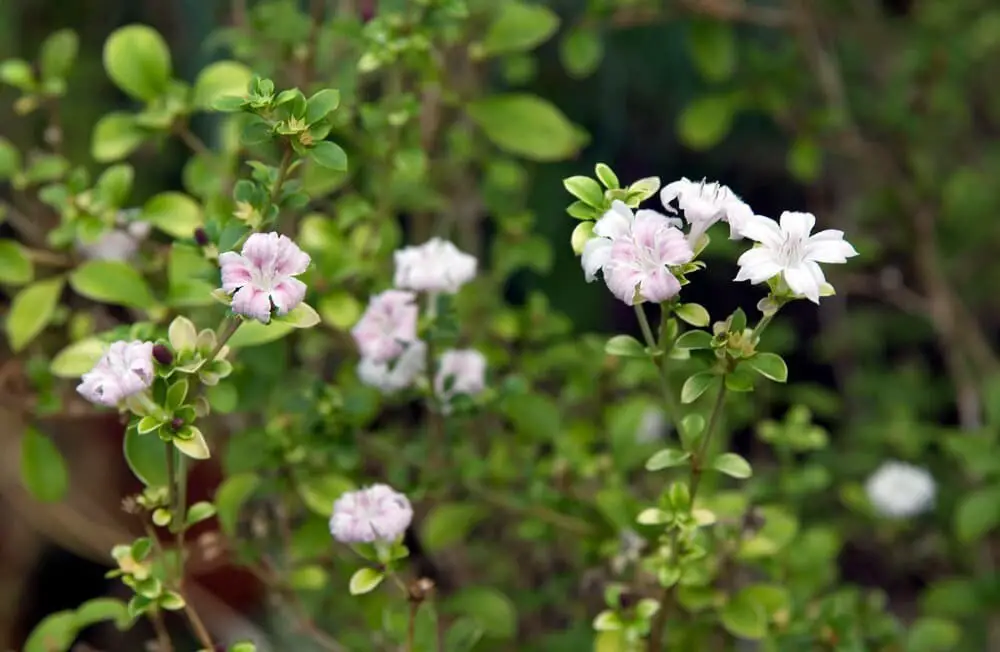
Native to China, India, and southern Asia, this evergreen shrub boasts a unique appearance. Its leaves are tiny, ovate, and glossy, with a dark green hue that complements its multiple branches and white flower clusters. The gray trunk is a striking feature, gradually lightening in color as it matures. To thrive, the shrub requires a temperature range of 10-20°C, necessitating careful maintenance to ensure optimal growth.
FAQs
Beyond the comprehensive list of white flowering trees, it’s essential to consider additional factors when selecting the perfect specimens for your outdoor space. To further refine your options, we’ve compiled a list of frequently asked questions about white flowering trees that will help you make an informed decision.
What tree has white flowers in May?
When it comes to spring flowers with a touch of elegance, white-blooming flowering trees are an excellent choice. Among the many options available, the following stand out as particularly impressive: Fringe tree, Giant Dogwood, Hawthorn, Pear trees, Crabapples, Yoshino cherry, Serviceberry, California buckeye, Tree hydrangea, Magnolias, Coastal silver bells, Callery pear, Catalpa trees, Blackhaw Viburnum, Bridal Wreath Spirea, Greybeard tree, and Tree lilac.
For a unique touch, consider Hackberry or American Mountain Ash, while the classic beauty of American Plum is also worth exploring.
What tree has white flowers in June?
If you’re seeking white flowering trees that bloom in June or throughout the summer, consider the following options for your landscape.
While there are many varieties to choose from, here are some top picks: Natchez crape myrtle, Japanese flowering cherry, Yellowwood, American smoketree, Japanese stewartia, Little leaf linden, Pekin lilac, Butterfly bush, Carolina allspice, Bottlebrush buckeye, Spirea, Bushclover, American elderberry, Chaste tree, Sourwood, Japanese snowbell, Franklinia, Spring snow crabapple, White rose of Sharon, Japanese pagoda tree, Raintree, Seven sons, Tulip tree, Rose tree, Amur Maackia, Summer Wine Ninebark, Purple leaf sandcherry, and Kousa dogwood.
Are there white flowering trees during winter?
If you’re searching for the perfect white flowering trees to adorn your winter garden, we’ve got just the list for you. Among the many stunning options available, here are some standout choices that will elevate your landscape to the next level: Japanese loquat, Japanese flowering apricot, White floss silk tree, Japanese magnolia, Snowdrift crabapple, Flowering quince, and Camellia tree, as well as Chickasaw plum.
These breathtaking beauties are sure to bring a touch of elegance and serenity to your outdoor space.
What white flowering trees bloom in the fall?
While it’s common to associate flowering trees with vibrant colors during the spring and summer, there are many beautiful options that bloom white flowers in the fall. In fact, some species of flowering trees remain in bloom throughout the dormant seasons of autumn and winter.
For a unique and striking display, consider featuring trees like Pacific dogwood, Fragrant tea olive, Seven son flower, Franklin tree, Autumn higan cherry, Winter King hawthorn, Carolina silverbells, Ornamental cherries, Virginia fringe tree, Star magnolia, Wolf eye dogwood, Crape myrtle, White angel crabapple, and European pear.
What tree has white flowers and red berries?
For a stunning and harmonious landscape, the combination of red and white is unbeatable. To achieve this visual delight, you can opt for trees that produce white flowers accompanied by vibrant red berries either before or after their blooming season.
Here’s a comprehensive list of such remarkable trees: Strawberry madrone, Mountain cabbage tree, Chinese photinia, Cotoneaster, Tatarian honeysuckle, Red chokeberry, Peruvian pepper, Buffalo berry, Nanking cherry, American bittersweet, Winterberry, Firethorn, Possumhaw, and American Cranberry. With these options, you’re sure to create a breathtaking landscape that’s both visually appealing and botanically diverse.
Conclusion
The allure of white flowering trees lies in their understated elegance and delicate beauty. As they burst into bloom throughout the seasons, they create a breathtakingly lovely display that can’t be ignored. With their radiant blooms serving as a beacon, these trees effortlessly become the crowning jewel of any landscape or garden. For those seeking the crème de la crème of white-flowered trees, look no further than the esteemed varieties showcased in this comprehensive list.






